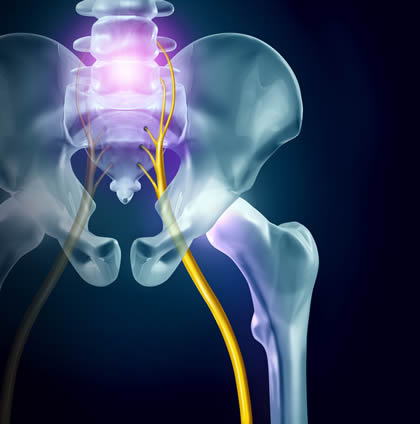The sciatic nerve reaches from the back of the pelvis, through the buttocks, through both legs, and ends at the feet. Sciatica pain occurs when the sciatic nerve becomes irritated or compressed. In addition to pain, many patients also experience weakness or numbness along the sciatic nerve. If you’re dealing with sciatica pain, some simple exercises and stretches that target certain areas of the body can help.
The first step is seeing a physician to make sure you have an accurate diagnosis of sciatica and are cleared to perform exercises and stretches. Dr. Fischer at NYU Langone Medical Center in New York City is qualified and experienced in treating patients with sciatica and can give you the go-ahead if this is a good way to address your sciatica pain. Since doing the wrong types of exercise can worsen sciatica pain, it’s important to get an accurate diagnosis before beginning any exercise program. Dr. Fischer is happy to help.
Although it might be tempting to rest in bed when your sciatica is acting up, movement is usually a better choice. After perhaps a day or two of rest when the pain begins, it’s advised to get moving because inactivity can actually worsen sciatica pain. You don’t want your back muscles to weaken and become less able to support your spinal structures, causing additional discomfort. Movement can help keep the discs in your back healthy and prevent pressure on your sciatic nerve.
To improve lower back flexibility and mobilize the sciatic nerve, try to perform simple stretches and exercises at least once a day. Begin gently and do the movements as much as you comfortably can without experiencing pain. Dr. Fischer can provide you with a list of activities that target these areas of the body to help with sciatica pain.
Core muscle strength
Having strong core muscles makes it easier and more comfortable to do many physical activities. Core muscles are those in your torso from your shoulders to your hips, including abdominal, back, and pelvic muscles. These muscles work together to protect your spine, especially your lower back. Exercises that target your core will improve your sciatic nerve function and make recovery easier and faster if sciatica does occur.
Hamstring stretches
Stretching the hamstring muscles benefits nearly all sciatica patients. These muscles, located in the back of the thigh, can become overly tight and increase stress on your lower back. Tight hamstrings can even lead to some of the conditions that cause sciatica pain. The goal is to stretch and lengthen the hamstring muscles, and to relieve pressure on portion of the sciatic nerve located in the thigh.
Hip stretches
The piriformis, which is a small muscle located deep in your hips, has been linked to sciatica pain. It can become tight and begin to compress the sciatic nerve, causing pain and numbness in your buttocks and down your leg. The hip flexors may also be involved, because tight hip flexors add stress to the piriformis muscle and may result in pinching the sciatic nerve. Stretching both the hip flexors and piriformis can reduce sciatica pain and help avoid its recurrence. In addition to stretching, using a foam roller on the hips can release tension and reduce pain.
Back stretches
A variety of back stretches can be done to improve the flexibility of your lower back. Examples of stretches that commonly relieve pressure on the sciatic nerve are back extensions and the cat stretch. A qualified health professional like Dr. Fischer can provide a list of appropriate back stretches and exercises.
Aerobic exercises
Aerobic conditioning benefits the overall fitness of your body. Find options that are easy for you to do if you’re experiencing sciatica pain, but still get your body moving and your heart pumping. Walking is one excellent form of aerobic exercise for the lower back, and its relatively low impact makes it possible for many sciatica patients. Gradually working up to longer walks and faster pace will increase the benefits of aerobic exercise.
If you are still experiencing pain, contact Dr. Fishcer today to schedule a consultation.

